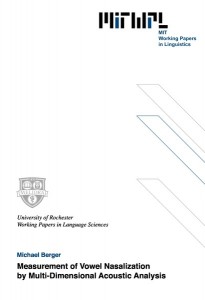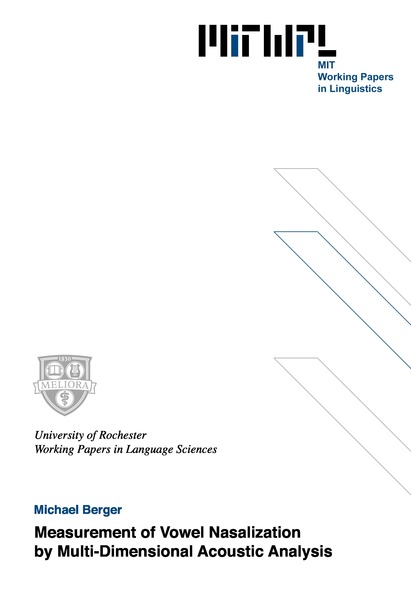University of Rochester Working Papers in the Language Sciences #41
Measurement of Vowel Nasalization by Multi-Dimensional Acoustic Analysis
Michael Berger, 2007
When the velum lowers during vowels, the velopharyngeal port is opened, and there is acoustic coupling between the nasal cavity and the main vocal tract, giving rise to a distinct acoustic quality which we call nasality. Nasal coupling results in energy losses at low frequencies, damping of oral formants (especially F1), and introduction of nasal formants corresponding to the resonances of the nasal cavity and sinuses. These spectral modifications are gradient, increasing with degree of velar lowering; this relationship suggests that velar position may be recovered from the acoustic signal by measuring the degree of nasality in the vowel. However, the acoustic effects of nasalization vary not only with velar position, but also across different speakers and vowels, making it difficult to isolate an acoustic dimension corresponding to nasalization. This thesis presents a methodology for acoustic measurement of nasality in vowels which attempts to overcome this contextual variability by a normalization procedure. The measuring technique is implemented in an automated measuring system, which is trained on a phonetically balanced set of words recorded from a particular speaker to generate a speaker-specific model. The model specifies the parameters with which to measure nasality for the speaker, the contextual variability of those parameters which may be subtracted for normalization, and the contributions of the parameters to an integrated measure of nasality. The system performs high-frequency nasality measurements over the time course of vowels to generate temporally detailed nasality contours. These measurements may be interpreted as a form of articulatory inference, or as a representation of perceptual input. The system is trained and tested on recordings of 17 native speakers of three languagesEnglish, Spanish and Bengalispeaking three types of vowels: oral (CV(C)), contextually nasalized (CVN), and contrastively nasalized (CV(C)) (Bengali only). The measuring system is evaluated using various performance metrics.

